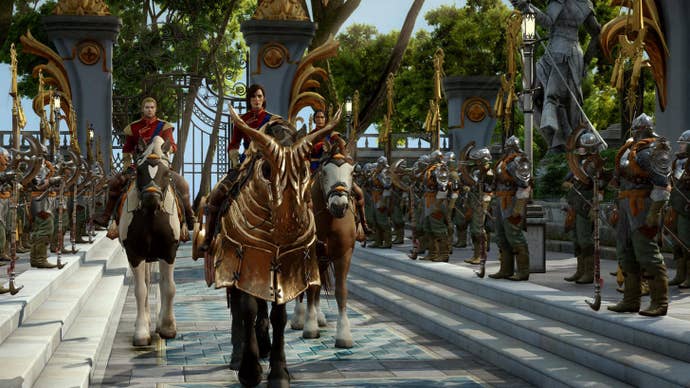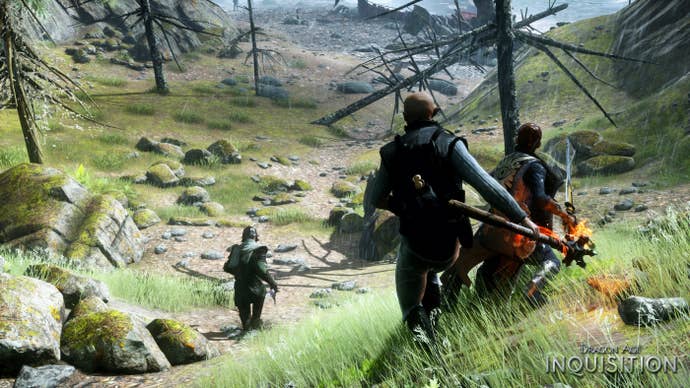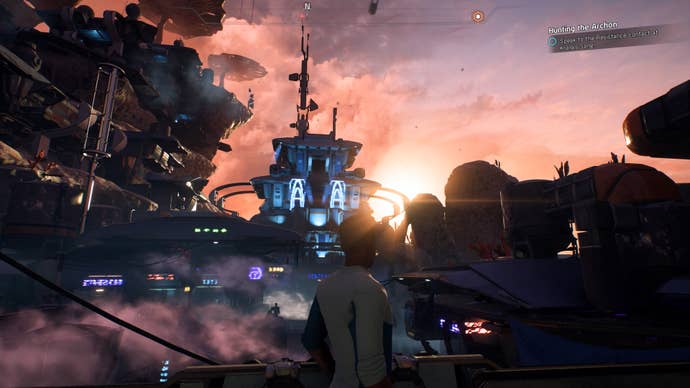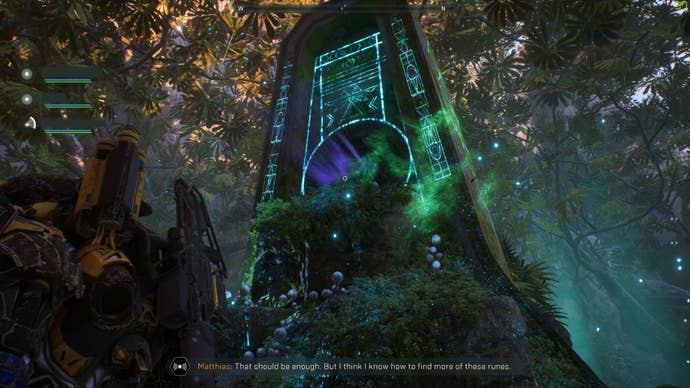How the Frostbite Engine Became a Nightmare for EA in General, and BioWare in Particular
DICE's engine finds a rough reception at other EA studios.
This article first appeared on USgamer, a partner publication of VG247. Some content, such as this article, has been migrated to VG247 for posterity after USgamer's closure - but it has not been edited or further vetted by the VG247 team.
After years of development, BioWare finally launched Anthem earlier this year to a wave of critical and community backlash. BioWare's next big thing didn't seem like it had it all together, leaving fans to wonder where the six years of dev time went. The answer was offered earlier this month when Kotaku's Jason Schreier published a fairly lengthy report on Anthem's development. The report noted a lack of directorial vision, several mechanics changes, and of course, issues with the Frostbite engine.
The latter has been a common problem at Electronic Arts studios. The last few BioWare titles-Dragon Age: Inquisition, Mass Effect: Andromeda, and Anthem-all had problems utilizing Frostbite during development. For fans, the engine has become a scapegoat for recent problems in EA franchises, from Need for Speed, to FIFA, to the Star Wars games. The perception is that Electronic Arts is forcing all of its studios to use Frostbite, which is borne out by nearly every EA title switching to the engine But some development leads have countered that belief.
"It was our decision," former BioWare general manager Aaron Flynn told Kotaku Splitscreen in regard to using Frostbite for Dragon Age: Inquisition. "We had been wrapping up Mass Effect 3 and we just shipped Dragon Age 2 and we knew that our Eclipse engine, that we shipped DA 2 on, wasn't going to cut it for the future iterations of Dragon Age. It couldn't do open world, the renderer wasn't strong enough, those were the two big ones. We thought about multiplayer as well, as Eclipse was single-player only."
But even if developers have taken on Frostbite willing, it has definitely caused some major issues across Electronic Arts studios. So it's worth looking back at the rough road that got the engine to where it is today.
What is an Engine?
Let's establish in rough terms what an engine is. It's software-development infrastructure that allows people to build video games. An engine is what developers craft their games on top of, providing them with several development necessities like a renderer, audio, scripting tools, artificial intelligence, animation, and physics simulation. It's a toolbox, allowing a developer to quickly to get to core of game development, rather than reinventing the wheel and rebuilding these tools from scratch. A good example is the old Infinity Engine games: BioWare made the engine for Baldur's Gate, but Black Isle Studios was able to use the Infinity Engine, skip that stage of development, and roll right into crafting the world and narrative of Planescape: Torment.
These days, many developers can turn to robust general engine like Unreal Engine, Unity, CryEngine, or MonoGame. These engines require development effort in order to make them do exactly what a studio wants, but they also have huge communities of other developers who are doing the same thing; there's a shared expertise that developers can draw on. Many of these engines also make it easy to port your finished game over to different platforms like PlayStation 4, Xbox One, Switch, PC, and even mobile.
Developing your own engine from scratch can be a much costlier affair, since you're building a framework from the ground up. The difference here is a bespoke engine can be directly tailored to your game, while a general-purpose engine is a jack-of-all-trades. There's also the issue of licensing fees. If you're using Unreal Engine, you pay 5 percent of your revenue to engine developer Epic Games when you ship your game. The additional cut taken by digital storefronts and other middleware can add up, lessening the actual profit a developer sees. With an in-house engine, you're not paying anyone; and if you stick to a certain genre, you're likely to have an engine that can roll forward from game-to-game.
Major publishers are keen to not pay licensing fees, but their handling of their own engines vary. Ubisoft has been rather successful with its handful of in-house engines: AnvilNext 2.0 powers Assassin's Creed Origins, Assassin's Creed Odyssey, and Ghost Recon Wildlands; Snowdrop has been used for Mario + Rabbids Kingdom Battle, Starlink: Battle for Atlas, and The Division 2. Capcom had its MT Framework and currently uses the in-house RE Engine for Resident Evil 7, Resident Evil 2, and Devil May Cry 5, while also licensing Unreal Engine for Street Fighter 5 and Marvel vs Capcom: Infinite. EA has tried to follow in their footsteps, but Frostbite hasn't been the one size fits all solution that it might have hoped.
Electronic Arts Moves to Frostbite
Electronic Arts used to have several studios that each utilized their own engines. The engines didn't always have keen names because they were just what the games were built on. The real shift began all the way back in 2006, when EA acquired Digital Illusions Creative Entertainment (later known simply as DICE). DICE had developed the successful Battlefield series (Battlefield 1942, Battlefield 2, and Battlefield 2142) for EA, and the publisher wanted to bring them further into the family.
DICE was beginning work on Battlefield: Bad Company, a game that wasn't aimed at the PC like previous Battlefield titles. Instead, Bad Company was coming to PlayStation 3 and Xbox 360. It was also the first game that would use Frostbite. Instead of building a new engine for each game, Frostbite would carry from game to game for DICE, improving with each iteration. By 2011, DICE was releasing Battlefield 3, which looked fantastic and showed off the power of Frostbite 2.
At the time of Battlefield 3's release, EA had a host of major franchises all using their own engines. EA Labels president Frank Gibeau wanted all the studios to get on the same page.
"Frank Gibeau, myself and others said that this has to stop; this has to get a unified platform because it's too expensive and inefficient for everyone to be operating off of different engines," former EA chief design officer Patrick Soderlund told Engadget at the time. The idea was to show the other EA studios how awesome Battlefield 4 looked, and point to Frostbite 3 as the reason. According Soderlund, BioWare and Need for Speed developer Ghost Games were the first to reach out about using Frostbite for their titles. Not everyone was up for switching to Frostbite though: EA Sports was about to switch to the Ignite engine for its 2013 releases, and third-party studios like Respawn Entertainment stuck to engines they were used to, like Valve's Source engine. Still, EA believed heavily in Frostbite.
"If you look at the magnitude and complexity of a Battlefield game-using Battlefield 4 as an example-you can see that you can build pretty much everything with this engine to a very, very high quality," said former EA DICE general manager Patrick Bach at the time.

The Troubles Begin
Seemingly, the major issue with Frostbite is that it was an engine built for a specific purpose: first-person shooting and multiplayer. The problem is manyEA games obviously aren't first-person shooters: BioWare builds RPGs, Ghost Games makes racing games, and Madden and FIFA are sports sims.
For Dragon Age: Inquisition, BioWare had to create a dialogue system within Frostbite and make an animation system for dogs and horses, but Frostbite could only animate bipedal creatures. For Need for Speed Rivals, Ghost Games had to rework Frostbite's streaming system to accommodate the speed at which its cars could move.
"You can drive around our world indefinitely, and that's something that wasn't without its teething pains, but now that it's in and working, it's a really powerful thing that any open-world title is going to be able to use moving forward," Need for Speed Rivals senior producer Jamie Keen told Engadget.
"We started with a really solid foundation of the engine but we had to build a lot around it," said BioWare producer Cameron Lee about using Frostbite on Dragon Age: Inquisition. "The concept of save games didn't exist, at least as Bioware knows them. The tactical camera, just being able to pause a game and still work within it, Frostbite didn't have that, it had no concept of that. We've had to add all of these things to it over the course of our development over the last four years. We built all of these different tools for the engine."
The idea was that all this knowledge could feed back into Frostbite, creating a general purpose engine for all of Electronic Arts. It's an excellent idea, but not one that has gone off without a hitch.

BioWare Hits The Skids
BioWare worked on another project prior to starting on Dragon Age: Inquisition, code-named Blackfoot. It was a multiplayer-focused Dragon Age, but it really was a way for BioWare to get used to Frostbite. The studio knew that The engine would provide challenges, but it needed a way to see how deep the well went.
"Frostbite doesn't really understand the idea of stats or items or saving a game, conversations, cutscenes. Like a bunch of things that we take for granted it doesn't even really conceptualize. We actually had a project code-named Blackfoot which was the first game we had that was looking at Frostbite. That became the core of what became Dragon Age Inquisition, the techlines, more than any of the development, so we've actually been looking at this a long time," said Inquisition executive producer Mark Darrah told GamesIndustry.biz back in 2014.
Implementing basic RPG features took a very long time in Frostbite. BioWare was working hard to build one of the biggest games it had ever crafted, partially inspired by Bethesda's The Elder Scrolls 5: Skyrim, while working with an engine not built for RPGs. It was like pulling teeth.
"I had to get to the conversation in-game, open my tools at the same time, and then as soon as I hit the line, I had to hit the pause button really, really quickly," Inquisition cinematic designer John Epler told Kotaku's Jason Schreier for his book, Blood, Sweat, and Pixels. "Because otherwise it would just play through to the next line. Then I had to add animations, and then I could scrub it two or three times before it would crash and then I'd have to start the process all over again. It was absolutely the worst tools experience I've ever had."
Worse, DICE was updating Frostbite with new features because the engine was being used for a host of games. So BioWare's developers were grafting new things onto an engine that was changing underneath them.
"There'd be times when the build wouldn't work for a month, or it was unstable as hell. Because the new version of the engine would come in, the tools team would start doing the integration. All the while, the team is still working and moving ahead, so it gets worse and worse and worse," Lee told Schreier.
Towards the end of development though, BioWare and DICE synced up better and Dragon Age: Inquisition started to come together. It finally launched on November 18, 2014, becoming one of BioWare's best-selling games. Frostbite had proved difficult to handle, but ultimately engineers at BioWare and DICE made it work. And those features who help in future BioWare games. It seems logical that all the work BioWare did for Dragon Age: Inquisition would flow right into Mass Effect: Andromeda. They're both RPGs, right?

Lost on the Way to Andromeda
BioWare Montreal, the team behind Mass Effect: Andromeda had big dreams. They wanted a title that would allow players to explore a galaxy of vast, procedurally-generated planets. It was supposed to fulfill the promise of the first Mass Effect, utilizing new technology.
Frostbite was missing features, but Inquisition was wrapping up when Andromeda went into pre-production, so the latter title was getting some of the features it needed. The problem was the outline for Mass Effect: Andromeda was actually a much bigger project than even Inquisition. Andromeda's maps were supposed to represent entire planets, so they needed to be bigger than even Inquisition's vast spaces, and Frostbite wasn't equipped to handle that.
"Whenever you're trying to do something that fits the engine-vehicles, for example-Frostbite handles that extremely well. But when you're building something that the engine is not made for, this is where it becomes difficult," one developer told Kotaku.
"It's been painful," said another. "The pain started with Dragon Age: Inquisition and continued on with Andromeda as well."
Mass Effect: Andromeda began pre-production in 2013, but by 2015 BioWare Montreal was cutting out the concept of procedurally-generated planets. Ultimately, due to this lack of direction, BioWare Montreal had to scramble to create the final version of Andromeda, most of the work coming in the last 18 months. And Mass Effect: Andromeda didn't fully right the ship prior to launch. Instead, it had a host of bugs and poor animations, leading to poor reviews and a bad reception in the community. Ultimately, BioWare Montreal was shuttered and merged in EA Motive.
The pain of what Mass Effect: Andromeda could've been, and what it was, lingers for some developers. One developer, Andromeda designer Manveer Heir, pointed to Frostbite as one of the big issues during the game's development.
"Frostbite is easily the worst, shittiest, most pain in the ass engine I've ever used in my career, and I shipped Wolfenstein off the Doom 3 tech," said Heir on Twitter. "The exact same game design in Unreal vs. Frostbite will take dozens more engineers, money, and time on FB because of the way its architected and how far behind it is from Unreal (unless you are making BF). There is a reason I chose Unreal Engine 4 as my engine for my next project."

The Ragtag Group Loses
While Dragon Age: Inquisition was wrapping up, EA acquired the exclusive license to make video games based in the Star Wars universe. The first title on the docket was Star Wars: Battlefront, a first-person shooter built by EA DICE, based on the older games developed by the defunct Pandemic Studios for LucasArts. Star Wars: Battlefront looked great thanks to the ongoing work on Frostbite, but fans hit it for a lack of depth and longevity.
As EA Dice was working on Battlefield 1 and a sequel to Star Wars: Battlefront, Dead Space and Battlefield:hardline developer Visceral Games was working on its own Star Wars title. The studio had hired Uncharted creative director Amy Hennig to make a grand Star Wars adventure, centered on the dirtier side of the universe. This was Project Ragtag.
The problem was again, that Project Ragtag was meant to be a third-person action-adventure game, not a first-person shooter. Frostbite didn't have all the tech needed to make it easy to craft the kind of game Visceral wanted. Like BioWare, it took twice as much effort to make things happen.
"We obviously had to take the Frostbite Engine, because there was the internal initiative to make sure that everybody was on the same technology, but it was an engine that was made to do first-person shooters not third-person traversal cinematic games," Hennig told USG earlier this year. "So building all of that third-person platforming and climbing and cover taking and all that stuff into an engine that wasn't made to do that. We did a lot of foundational work that I think the teams are still benefiting from because it's a shared engine, but it's tough when you spend a lot of time doing foundational stuff but then don't get to go ta-da! [laughs] You know, here's the game."
As the project dragged on at Visceral Games, Electronic Arts ultimately decided to shut down the studio. It moved what was Ragtag over to EA Vancouver, refocusing the linear action-adventure into an open-world one. Ultimately, Electronic Arts cancelled that game as well, leaving the only Star Wars releases from the publisher being Star Wars: Battlefront, Star Wars: Battlefront 2, and the upcoming Star Wars Jedi: Fallen Order. The latter game is being built by Respawn Entertainment in Unreal Engine 4.

EA Sports Are Complicated
From 2013 to 2016, EA Sports was using its own in-house Ignite engine to power all of its sports titles, including FIFA, Madden NFL, and NBA Live. With the releases of FIFA 17 and Madden NFL 18, those titles have switched over to using Frostbite as their primary engine. With the move to Frostbite came the addition of new cinematic story modes—Madden NFL's Longshot and FIFA's The Journey—which developers have said is all because of the new engine.
"I had met with their people and actually pitched this idea to all of the EA Sports teams this crazy idea of Longshot, and I had been pitching a campaign mode for sports. I'm pretty sure without Frostbite we really couldn't do it, and that's one of the things that held us back from trying to execute this thing, and they were getting Frostbite first. In the meantime, I think they were seeing some of the other sports franchises go down this path and have some success. So I think everyone will assume that Madden saw The Journey's success and followed in its footsteps, but we've had our own path to get to this point," Madden NFL 18 creative lead Mike Young told USG.
Young pointed to Frostbite's excellent content engine and shaders for allowing the Madden NFL team to build out a cinematic storytelling experience in a way it couldn't with Ignite. Everything didn't go off without a hitch though. Madden NFL 18 was a transition year: it looked better, but it missed some of the cleaner features and smoother motion players had come to expect from the Ignite Maddens. EA Sports introduced Real Player Motion in Madden NFL 19, a new animation system intended to make the on-field action feel real, but once players had it in their hands, they noticed the bugs and freezes. Even the Frostbite FIFA games have had complaints about choppy pacing and input lag.

"There are often some bits and pieces left behind," Madden NFL 19 gameplay lead Clint Oldenburg admitted to USG. "You're not really aware it ever existed until it gets into Frostbite, and when you start playing the game you're like, 'Wait this thing's not working. Oh man we forgot the motion system.'"
Despite the two key sports titles making the move, not every EA Sports franchise has switched over. NBA Live 19 and NHL 19 still use Ignite, while EA Sports UFC 3 uses the all-new RPM Tech engine. NHL's steadfast hold against Frostbite has been noticeable to the community, and according to the developers, that's because they don't want to lose features in the transition to the new engine.
"Really, we have so much invested in what's built in Ignite. And right now we feel that we don't really want to go into a transition year where... well, in our last transition year, a lot sort of had to be left on the cutting room floor, right? We didn't deliver to our fans expectations and so right now we've got a critical mass of different modes where people are investing in them, they're playing them. They want Threes. It runs in the current engine. We built our customization in it and so, right now, we're trying to deliver to more fans expectations. I'm not sure that transitioning to Frostbite right away would actually deliver what our fans expect," explained NHL 19 creative director William Ho to USG.
NHL 19 was a give-and-take though. When USG's Kat Bailey took a look at this year's entry, she found a game that captured the speed and excitement of hockey, with very dynamic crowds, but it was also lacking the visual prowess in the players themselves, something that might be down to the older engine. Of course, FIFA 19 looks like the real sport visually, but ultimately isn't that fun to play. Finding out the correct direction for all of its franchises is an ongoing struggle for EA Sports.

Dirge, Not an Anthem
In the meantime, Andromeda might have been a big pothole for BioWare, but fans still had hope. BioWare's massive next-gen game was finally revealed in June 2017 at E3. It was called Anthem, and featured players going up against a massive untamed environment in exo-suit called Javelins. BioWare had been working on Anthem since 2012; it was using Frostbite, but surely the work on Dragon Age: Inquisition and Mass Effect: Andromeda meant that Anthem would be fine.
Not really. The same problems that plagued Andromeda resurfaced here. BioWare didn't quite know what Anthem was during development, and while some of the systems could be ported over from their previous games, Anthem was firmly a multiplayer online experience. There's not much connection between the types of games Anthem, Dragon Age: Inquisition, and Mass Effect: Andromeda are. So again, BioWare had to craft new features within Frostbite and again, it wasn't a pleasant task.
"It's hard enough to make a game," one former BioWare employee told Kotaku. "It's really hard to make a game where you have to fight your own tool set all the time."
Different game, same story. BioWare began to cut back on planned features for Anthem, like real-time weather, because trying to get them working in Frostbite was taking forever. One developer said it can take "a week to make a little bug fix". Getting some of the ideas working in Frostbite required as much work as making a new engine.

"Part of the trouble was you could do enough in the engine to hack it to show what was possible, but then to get the investment behind it to get it actually done took a lot longer, and in some cases you'd run into a brick wall," a BioWare developer told Kotaku. "Then you'd realize, 'Oh my god, we can do this only if we reinvent the wheel, which is going to take too long.' It was sometimes difficult to know when to cut and run."
Worse, engineers within EA's Frostbite team were spread thin. If every game is using Frostbite at your publisher, then you need to spread that expertise around. The Frostbite team was helping with FIFA, because that made a ton of money for EA, so BioWare's Anthem team trying to find time to sync up with them was hard. BioWare had little help, things kept changing with the game's design, and implementing these new changes in Frostbite was very time-consuming.
Like Mass Effect: Andromeda, Anthem launched to a critical drubbing, worse than BioWare's previous game. Mass Effect: Andromeda lowest Metascore is 71, while Anthem's is 55. Regardless, BioWare is continuing to push forward, improving Anthem where it can. And the studio is still working on another Dragon Age, though that project was cancelled at one point to get Anthem out the door. Will this be the project where BioWare and Frostbite finally come together in a beautiful whole?
Not all of Electronic Arts' problems are related to Frostbite though. Ghost Games has shipped three Need for Speed titles, all built in Frostbite. The biggest EA Sports games are developed on Frostbite, and while they do have some issues with play feel, the developers are seemingly still onboard.
Electronic Arts as a whole could eventually get to the place management wants, a robust engine that can be shared across all developers. But for fans, it can be hard to look at the company's most recent and upcoming exciting games, Apex Legends and Star Wars Jedi: Fallen Order, and notice neither is developed in Frostbite.











